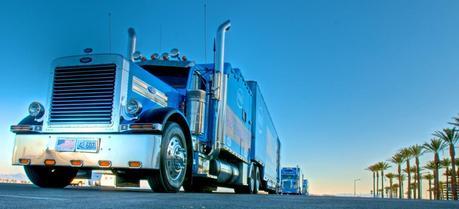 The use of natural gas as a fuel may reduce fuel consumption in medium- and heavy-duty vehicles. (Credir: Flickr @ Ryan Holst https://www.flickr.com/photos/holstphoto/)
The use of natural gas as a fuel may reduce fuel consumption in medium- and heavy-duty vehicles. (Credir: Flickr @ Ryan Holst https://www.flickr.com/photos/holstphoto/)Expanding the use of natural gas as a transportation fuel and greater use of aerodynamic devices on trailers are among the strategies recommended by a new National Research Council report for reducing fuel consumption by tractor-trailers, transit buses, commercial vehicles, trucks, and other medium- and heavy-duty vehicles.
The report follows a 2010 Research Council report whose findings and recommendations informed the “Phase I Rule” on fuel consumption and greenhouse gas emissions of medium- and heavy-duty vehicles issued jointly by the National Highway Traffic Safety Administration and U.S. Environmental Protection Agency. The new report offers guidance for the “Phase II Rule” under development, which is directed at technologies and programs in the post-2018 time frame.
Among the new engine and vehicle technologies introduced since the Phase I Rule, the emergence of natural gas as a transportation fuel is significant, the report says. Due to low carbon content, the greenhouse gas emissions of natural gas are lower than for gasoline or diesel fuel, but this benefit is partially negated by the lower efficiency in currently available engines and may be offset by the increased greenhouse gas effects of methane. In addition, the natural gas fueling infrastructure is underdeveloped and will require large investments to provide enough stations to prevent disruption in routes and travel times for longer-haul trucks.
In light of these trade-offs, the report recommends that NHTSA and EPA develop a separate standard for natural gas vehicles as is presently the case for diesel- and gasoline-fueled vehicles. It adds that the agencies should begin to consider the “well-to-tank” energy consumption and greenhouse gas emissions associated with natural gas vehicles as well as for other vehicle and energy technologies that include biofuels, dimethyl ether, and hydrogen fuel cells.
The committee that wrote the report found that the majority of both new and in-use van trailers currently do not use fuel-saving aerodynamic devices. Use of these devices, in particular side skirts, provides a full return on investment through fuel savings in about one year, on average. However, when a trailer is not owned by the tractor owner/operator (who pays for fuel), there is no incentive for the trailer owner to purchase fuel-saving devices. The report recommends that the agencies adopt a regulation requiring that all new 53 foot or longer dry van and refrigerated van trailers meet performance standards that will reduce fuel consumption and CO2 emissions.
The 2010 Research Council report recommended that NHTSA conduct a pilot program to collect baseline data for evaluating the effectiveness of regulations on fuel consumption in various industrial sectors and parts of the country. While the agency was unable to undertake the pilot program due to its mandate to issue its rule quickly, the committee recommends that NHTSA establish a repeatable, reliable data collection process as soon as possible.
A number of strategies that do not involve changes to the engine or vehicle are also available for reducing fuel consumption, the report says. These include changes to fleet operations and logistics, innovations in infrastructure, traffic management, and driver training and other behavioral initiatives. Market or regulatory factors may also directly or indirectly affect fuel consumption. NHTSA should carefully consider and attempt to quantify the impacts of these nonvehicle approaches on the costs and feasibility of future fuel consumption improvements, and work with EPA, Federal Highway Administration, U.S. Department of Energy, and the private sector to create incentives that capture the benefits of approaches other than regulating the vehicle.
This report was intended to inform the development of the Phase II Rule. The committee will expand upon this work and issue a final report in 2016 that will cover a broader range of technologies and approaches that address the 2025-2030 time frame.
The report was sponsored by the U.S. Department of Transportation. The National Academy of Sciences, National Academy of Engineering, Institute of Medicine, and National Research Council make up the National Academies. They are private, independent nonprofit institutions that provide science, technology, and health policy advice under a congressional charter granted to NAS in 1863. The National Research Council is the principal operating arm of the National Academy of Sciences and the National Academy of Engineering.

